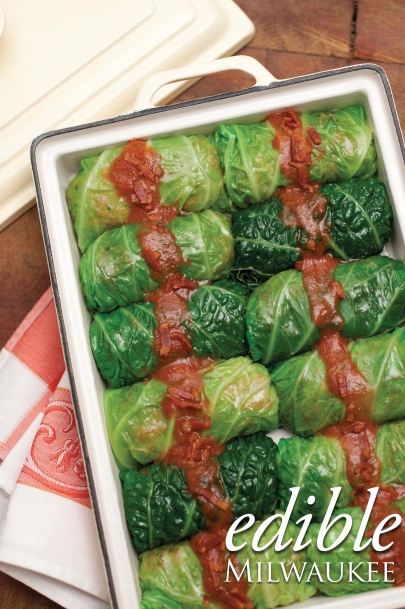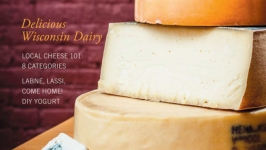Mon Petit Chou: Love and Cabbage
For my wife’s, Angie, and my first date, I picked her up at her grandmother’s home on the East Side, where she was living while attending college at UWM. I rang the bell at the back door and she ushered me into the tiny hallway. She quickly grabbed her coat off the hook and mildly flustered, said, “Smell that? I have to eat that later.” It was the unmistakable fragrance of cabbage.
There was no need for any embarrassment, as I was quite at home with cabbage. The aroma (or smell, depending on what camp you’re in) would permeate every nook and cranny of my childhood home. It would mean only one thing: boiled dinner. In our house, it was a combination of smoked pork butt, onions, carrots, garlic, potatoes and cabbage—a hearty meal, even if it only had half the ingredients. I loved the flavor combination of the slightly fatty, smoky pork against the silky richness of the cabbage. In fact, this was one of the first meals that I cooked for myself when I went out on my own— very warm, satisfying and homey.
Turns out that Angie’s grandmother, Martha, with her Polish roots, was a cabbage maven. For her, it was a bi-weekly experience, and Angie waxed lyrically about cabbage with melted butter in the same way I spoke about Sicilian spiedini.
Cabbage doesn’t have the protective armor of other cold weather root vegetables and winter squash, but don’t let that fool you. Cabbage is a keeper, having a terrific shelf life under cool conditions.
More than any other vegetable, it has managed to capture and embody the “humble” moniker. Name the cuisine, and cabbage will be present, always seeming to support—but in reality, it comprises the backbone that holds it all together. What would Korean food be without kimchi? Corned beef lacking cabbage is just a bunch of blarney. A proper French pot au feu would flounder sans cabbage. German cuisine “mittout” sauerkraut is a loud nein! And the Polish, Russians, Hungarians, Czechoslovakians, Serbians and Croatians, to name a few, would roll over and die before they would give up their cabbage.
Angie and I have had many great meals in our lives, but none was as unexpectedly memorable as Le Florimond in Paris in 1992. At the suggestion of our waiter, we ordered the “chou farci” or, stuffed cabbage. The waiter lifted the lid of the oval cocotte and lovingly elevated the tender rolls from their viscous, aromatic broth onto stark white plates. They were then draped with the broth and a few molten carrots. Our first taste was almost shocking as their magnificent flavor belied their Spartan presentation. We quickly realized that anything more would have been superfluous—this was a perfect dish.
The two recipes that follow are first, my take on those succulent cabbage rolls. This recipe takes a bit of time, but the results are well worth it. The second, which takes almost no time, is simply steamed cabbage sprinkled with the best quality fruity Provencal extra-virgin olive oil you can procure and a dusting of crunchy fleur du sel, the “lace filigree” of salt that is harvested before the water evaporates to render sea salt. The humble cabbage is a sublime partner for these luxury ingredients.
In the next few months you owe it to yourself to pick up a large fresh cabbage from a farmers market or any of the roadside stands. Then steam it up and you might find yourself proudly saying, “Smell that? I’m not sharing!”
Stuffed Cabbage Rolls
Yields 8 large cabbage rolls
For the pork stuffing reduction:
3 T. regular olive oil
2 med. onions (1 pound), peeled and diced small
1 bay leaf
1 sprig fresh thyme
3 cloves garlic (1 oz.), peeled and finely chopped
1 c. dry white wine
Place a saute pan over medium heat and add the olive oil. When hot, add the onions and cook for 3 minutes. Add bay leaf, thyme, and garlic and saute for 1 minute. Add the wine and reduce to dry. Place on a plate to cool and chill in the refrigerator.
For the pork stuffing:
Prepared pork stuffing reduction
1 c. dry plain bread crumbs, mixed with ¼ c. water
¾ c. tomato paste
3 large eggs
½ c. chopped fresh Italian parsley
2 T. kosher salt
1½ t. freshly ground black pepper
1½ t. ground cinnamon
3 lb. ground pork
Mix all of the ingredients, except the ground pork, together well. Add the pork and mix with hands until blended. Reserve the pork stuffing in the refrigerator.
For the cabbage rolls:
1 head Savoy cabbage (you will need 12–16 large leaves)
Prepared pork stuffing
Heat a large saucepan of salted water to a boil. Remove and discard the core from the cabbage and carefully peel away the whole leaves. Blanch the leaves in the water for about 2 min. Shock the leaves in ice water then drain in a colander until they are fairly dry. Cut halfway up each leaf to remove the heavy coarse part in the middle of the cabbage leaf. Divide pork stuffing in 8 portions. Place the stuffing in the middle of leaves and roll like you would an egg roll by folding the sides of the cabbage inward, then rolling to form a roll, about 5-in. long by 2-in. wide. Place the rolls in a non-reactive baking dish that is large enough to hold the 8 rolls. (If you are making sauce immediately, you can leave rolls out, but if you are making it later, refrigerate the rolls and remove them from the refrigerator when you start to make the sauce.)
For the sauce and to finish the dish:
¼ lb. bacon, cut in ¼-in. thick matchstick-sized pieces
1 sm. onion (6 oz.), peeled and diced medium
1 sm. carrot (1½ oz.), diced medium
1 stalk celery (2 oz.), diced medium
2 bay leaves
2 sprigs thyme
1 cinnamon stick
1 whole star anise
1 t. whole peppercorns, crushed
2 cloves garlic (½ oz.), thinly sliced
¾ c. red wine vinegar
1¼ c. dry white wine
¾ c. tomato paste
3¾ c. unsalted chicken stock
Kosher salt and freshly ground black pepper to taste
Place a sauce pan over medium heat. Add the bacon and cook, stirring, until lightly golden, about 2 to 3 min. Remove the bacon from the pan with a slotted spoon and reserve. Leave the fat in the pan. Add the onions, carrot, and celery and saute until lightly golden, about 4–5 min. Add the bay leaves, thyme, cinnamon stick, star anise, crushed peppercorns, and garlic and saute 1 min. Add the vinegar and reduce to dry. Add the white wine and reduce by half. Add tomato paste and cook, stirring, for 1 min. Add the chicken stock and bring up to a boil. Cover the pan, remove from the heat, and let it steep for 15 min. Preheat the oven to 350 degrees. Strain the sauce through a medium strainer over the cabbage rolls. Cover the top of the baking dish with a piece of parchment paper, then cover the dish with aluminum foil. Bake for 1¼–1½ hrs., or until cooked through. Remove the stuffed cabbage to plates. Add the reserved bacon to the sauce, adjust the seasoning with salt and pepper, and serve along with the cabbage rolls.
Market Cabbage With Olive Oil and Sea Salt
4 servings
1 head of market cabbage, outer leaves trimmed, cut in 4 wedges through the core keeping the wedges intact
Good-quality extra-virgin olive oil (for this I prefer fruity French oil from Provence)
Sea salt
Place a ½-in. of water in a 12-in. saute pan with a cover high enough to cover the cabbage wedges. Place over high heat and bring up to a boil. Add the cabbage wedges in, cover and steam for about 7–10 min. until the cabbage is tender and just cooked. Remove from the pan and place on 4 plates. Drizzle the olive oil over the top and sprinkle with sea salt. Serve.






